Last Updated on April 4, 2024
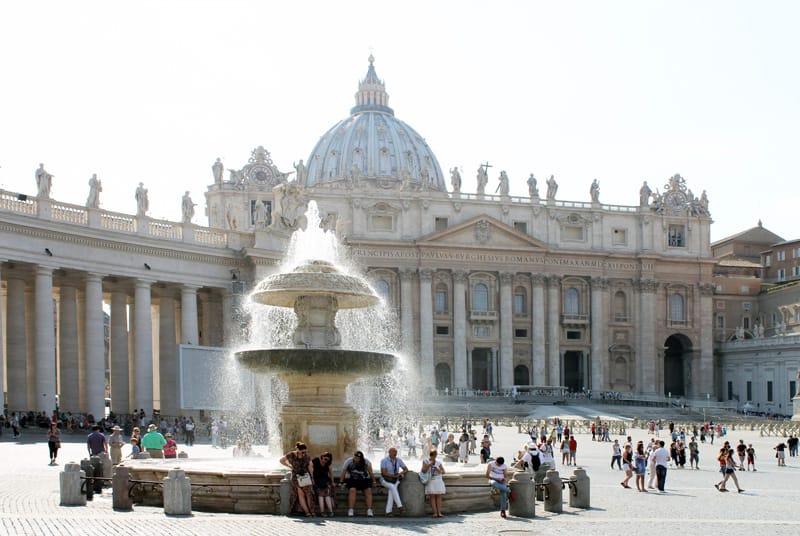
Estimated reading time: 21 minutes
By Jim Ferri
Walks in Rome are exceptionally enjoyable. Moreover, they’re really the only way to get a good view and understanding of the city. They’re also a way to sample some of the best gelatos and other foods of the city.
And with the information you can easily find online and in guides, there’s no need to hire someone to show you around. That’s usually the case in large international cities.
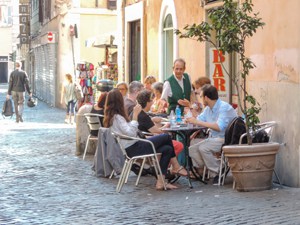
Of course, there are exceptions. You may want to get a better understanding of local culture. Or delve deeper into a subject with an art or food specialist. That’s all understandable.
But there are so many things to do here, you can see much on a self-guided walking tour of Rome. One you put together yourself either online or with a good guidebook (more likely both).
What makes Rome walks so interesting for a self-guided tour is that the city is a layer cake of history. In addition, it’s also one of Europe’s most ancient cities and a trove of old architecture and world-class art.
Needless to say, a lot of that architecture and art is all around you in churches, public buildings, tiny streets, and alleyways.
Yes, walking is the best way to see Rome, one of the best places in Italy. Even better is just slowly ambling along on your own private walking-in-Rome tour. On your own schedule…stopping for a coffee or gelato…getting a taste of local culture.
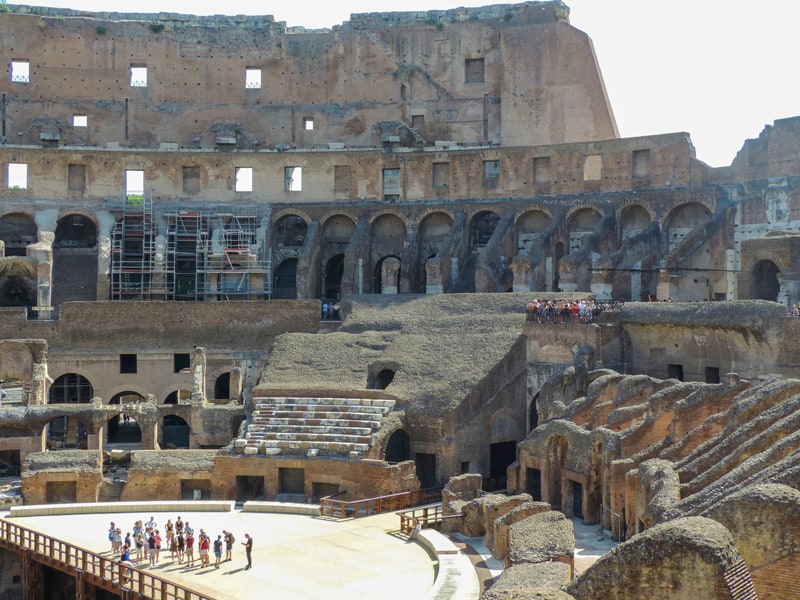
# 1 The Colosseum to Largo di Torre Argentina
The Colosseum is the symbol of Rome and an excellent place to start this tour. Above all, it was famous as the site of competitions, including its infamous gladiator fights. Even naval battles were staged here.
The adjacent Roman Forum / Imperial Fora was the center of trade for the empire. Set between Palatine Hill and Capitoline Hill, the Forum contains 1500 years of ancient monuments and temples.
Although all in ruins, you’ll see remnants of temples to Roman gods, the arches of the Roman Senate, and more.
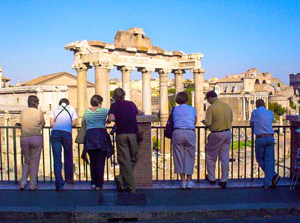
When you exit the Colosseum and Forum, cross the busy Via dei Fori Imperiali and turn left and continue walking. In a few minutes you’ll come to Trajan’s Markets, set back on your right. Due to the dark brick, it’s almost impossible to discern from across the road.
One fascinating thing you’ll see onn this Rome walk is that while built in the early 2nd century, Trajan’s Markets is actually a modern-looking shopping mall that held 150 shops. The top floor contained offices. Nearby is Trajan’s Forum and Column, the latter heralding the emperor’s victories in what is now Romania.
In addition, near all of this is Le Domus Romane di Palazzo Valentini. Through the glass floors in the 16th-century building, you can view excavations of ancient Rome.
Walk two-minutes further along Via dei Fori Imperiali to the Piazza Venezia and look at the buildings across the street to your right. The second-floor balcony on one of the buildings was where “Il Duce,” Benito Mussolini, made his fascist speeches to the crowds.
• Don’t Miss the Wedding Cake and Piazza del Campidoglio
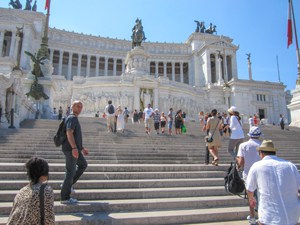
By now, you can’t help but see the immense Vittorio Emanuele II Monument, nicknamed the “wedding cake” by Romans, on your left. The monument holds Italy’s Tomb of the Unknown Soldier.
It was built in the early 20th century to honor the first king of unified Italy, with the tomb added later. Nevertheless, in aesthetically minded Rome, almost every Roman hates it and considers it a huge eyesore.
You can take an elevator to its roof (a pricey ride) for some good photos of Rome and the Forum. There’s also a bar where you can linger as long as you like.
Back on the sidewalk, continue along the street to the adjacent Piazza del Campidoglio atop Campidoglio Hill, one of Rome’s seven hills.
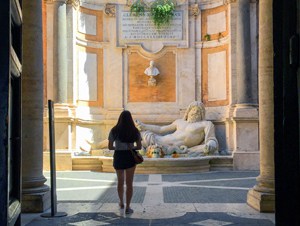
The wide “steps,” the entrance to Piazza del Campidoglio, were designed by Michangelo to allow horses to reach the Piazza above.
Once the religious heart of ancient Rome, today it’s better known for the interesting museums surrounding the Piazza. The newest museum is one dedicated to Roman cooking. You’ll likely want to spend some time here.
Before you leave, however, go behind the building at the far end of the Piazza. There you’ll find a beautiful view over the Roman Forum, an excellent and little-known spot for photos.
Just a 10-minute walk from Campidoglio is Largo di Torre Argentina. It was here that the Roman Senate was temporarily meeting in 44BC when Julius Caesar was stabbed to death. In addition to the ruins, the site today has a large colony of cats.
If You Go:
Colosseum
https://www.thecolosseum.org/
Open: 9am – 7:15pm daily
Admission: fees vary and are complicated. See them here:
Vittorio Emanuele II Monument
https://vive.beniculturali.it/en/vittoriano
Open: 9:30am to 7:30pm (last entry at 6:45pm)
Admission: Regular ticket €12 / 18-25 years old €2 / Free entrance on the first Sunday of the month. There is an additional charge for the panoramic lifts.
Trajan’s Market & Imperial Forum Museum Tickets
https://www.mercatiditraiano.it/en
@ [email protected]
Open: Daily 9:30am–7:30pm (December 24 and 31: 9:30am–2:00pm). Closed January 1, May 1, and December 25. Last admission one hour before closing.
Admission: €11-13
Le Domus Romane
https://www.palazzovalentini.it/domus-romane/index-en.html#info
Open: daily, except Tuesday, 10:00am to 7:00pm (last admission at 6:00pm)
Admission: Adults: €12,00 / Seniors 65+ and EU citizens: €8 / Students: €6 / 6 years and younger: free
Capitolini Museums
https://www.museicapitolini.org/en
@ [email protected]
Open: Daily 9:30am–7:30pm (December 24 and 31: 9:30am–2:00pm). Closed January 1, May 1, and December 25. Last admission one hour before closing.
Admission: €14-16
Largo di Torre Argentina
https://www.turismoroma.it/en/places/largo-di-torre-argentina
Open: 24 hours a day
Admission: free
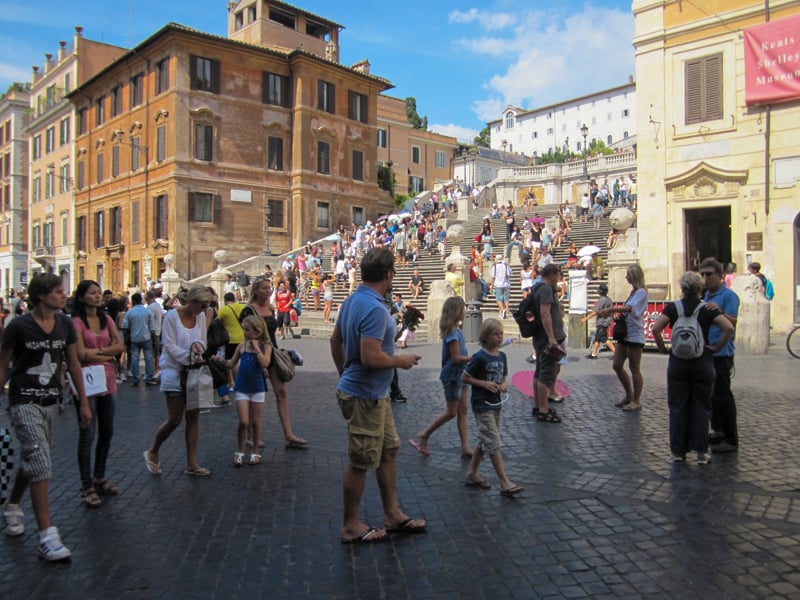
# 2 The Spanish Steps to Santa Maria del Popolo / Centro Storico
Start this walk in Rome at the famous Spanish Steps, the longest and widest staircase in Europe. They were built on the side of Pincio Hill, another of Rome’s seven hills.
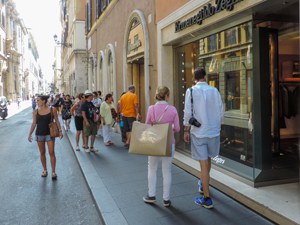
Initially built by the French, they later became the “Spanish Steps” after Spain’s Embassy relocated to the square. The steps sit on the Piazza di Spagna and run-up to the Trinita dei Monti church at its top. Note that no one is allowed to sit on the steps.
Alongside it you’ll see the Keats-Shelley House, a shrine to Romantics, where John Keats died in 1821. Unfortunately, or fortunately, depending on your outlook, you can no longer sit on the steps. Do so and s policeman/woman will tell you to move. The fine for breaking the law can be as much as €400.
Facing the steps is Rome’s famous shopping street, Via Condotti, lined with the luxury labels of Europe. It’s a good walk in Rome for shoppers.
Here also, is the historical and beautiful Antico Caffé, one of the hangouts of Keats. Take a look at its beautiful interior. Even better, stop in for a coffee before heading back to the Piazza.
When you reach the piazza, turn left and walk up Via del Babuino towards the Piazza del Popolo, about a 10-minute walk. On the far side of the Piazza, you’ll see steps leading up to the Villa Borghese. Don’t take them now (leave them for another walk in Rome) but instead head directly across the Piazza to the church Santa Maria del Popolo.
Santa Maria del Popolo is both a church and an incredible “museum” with art from the Early Renaissance to Baroque. You’ll find works by Raphael, Caravaggio, Bernini, Pinturicchio, and others in its beautiful interior.
• 2 Options on Walk # 2
When you leave the church, you have two options to continue your walk in the city.
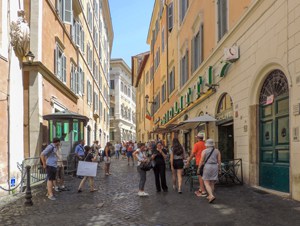
You can climb the steps to the left up to Villa Borghese (see below) or wander through the warren of streets you passed on your way to the Piazza del Popolo.
I often do the latter, since I love this area of Rome, the northern part of the Centro Storico, the old city center. This neighborhood is classic Rome and is a great and pleasurable place to wander. When I first started visiting Rome decades ago, this was a walk in Rome I took often.
These neighborhoods are chock full of little restaurants. It may sound funny but in the early afternoons of visits years ago, I’d watch for those in which nuns were dining. After all, I correctly surmised that they were on a budget and knew which restaurants provided the best value. In the evening, I’d return to one of them for dinner, which was always delicious and relatively inexpensive.
If You Go:
Spanish Steps
Open: 24 hours per day
Admission: free
Santa Maria del Popolo
Open: Monday-Friday 7 am – midday and 4 pm – 7 pm / Saturdays 7:30 am – 9 pm / Sundays 7:30 am – 1:30 pm and 4:30 pm – 7 pm
Admission: free
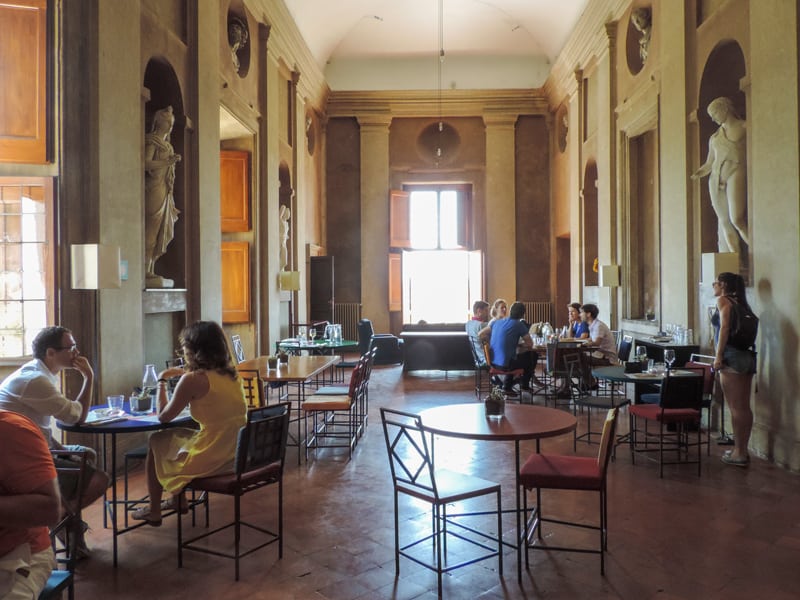
#3 Take a Walk in a Roman Park: Villa Borghese
Encompassing 1,700 acres (688ha), Villa Borghese is the third largest park in Rome, and arguably it’s most famous. It’s exceptionally worthy of a walk in Rome, either a half- or full-day.
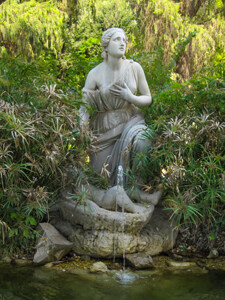
This is the Borghese family’s estate, which was among the most powerful families during the Renaissance, along with the Medicis. The beautiful Villa Medici, adjacent to the Villa Borghese near the Spanish Steps, is home to the French Academy.
Although most travelers don’t realize it, you can dine in the Villa Medici and it is a wonderful experience. Also, the price is just as wonderful, averaging about €30 per person.
It provides guided tours daily (closed Tuesday), which must be reserved in advance. Although the palace was built in the 16th century, the adjacent gardens (part of the Villa Borghese) are more than 2,000 years old.
• Exceptional Art in the Galleria Borghese
On the eastern end of the Villa Borghese, the popular Galleria Borghese contains an exceptional collection of art from the Classical and Renaissance periods, including works by Caravaggio, Bernini, and Canova. Accordingly, as you might suspect, reservations are required.
Be sure to walk about the grounds of this beautiful park. In addition to the museums, you’ll also find a small zoo and a replica of Shakespeare’s Globe Theater. The park is an excellent place to escape the noise and congestion of the city.
If You Go:
Villa Medici
https://www.villamedici.it/en
@ [email protected]
Open: Monday, Wednesday, Thursday, Sunday from 10am to 7pm (closed Tuesday) / Friday and Saturday from 10am to 7:30pm
Admission: Self-guided tours of the Villa Medici’s gardens + a current exhibition are €6-8. Tours are given only in French and Italian. Guided tours are €11-14. Some visitors qualify for free admission (see the qualifications here).
Villa Borghese
Open: daily from dawn to dusk
Admission: there is no admission fee for the park
Galleria Borghese
https://galleriaborghese.beniculturali.it/en/visita/
@ [email protected]
Open: Monday to Friday 9 am – 7pm (no entry after 5pm)
Admission: €2-13 / under 18 years free
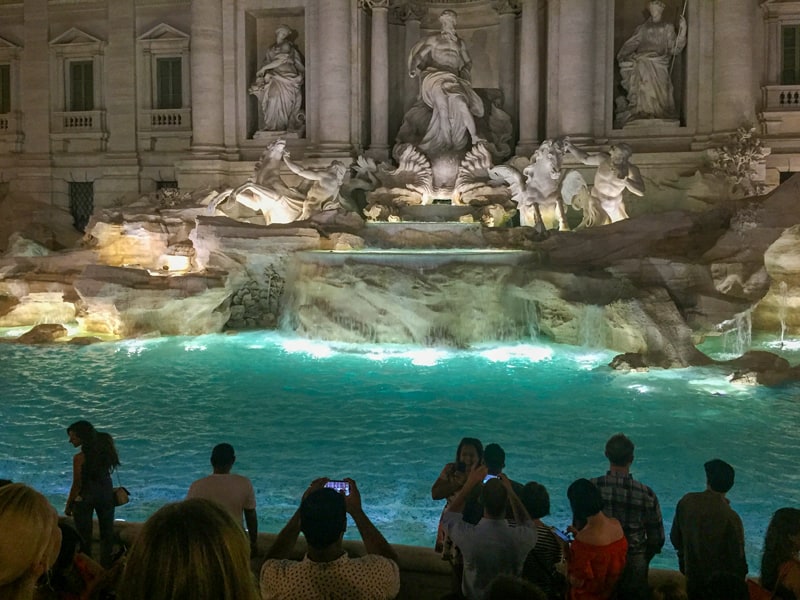
#4 A Good Walk in Rome: Trevi Fountain to Campo de’ Fiori
Trevi Fountain is the largest Baroque fountain in Rome and one of the city’s most famous sites. What many don’t realize though, is that it was the terminal for one of the city’s ancient aqueducts. It owes its present-day fame to Federico Fellini’s La Dolce Vita.
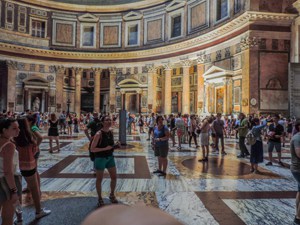
The fountain, depicting Neptune in a chariot being drawn by sea horses guided by Tritons, is one of Rome’s largest crowd magnets. Toss a coin – over your shoulder with your back to the fountain –to ensure a return visit to Rome.
The money collected from the fountain (€1.5 million a year) used to be given to a Catholic charity. However, in response to a public clamor, it is now used to fix potholes and other Rome infrastructure problems.
The fountain is a 10-minute walk from both the Spanish Steps to the west and the Barberini metro station to the east.
When leaving Trevi, go to the right on Via delle Muratte, the street on which the fountain is located. Although the street changes names along the way, continue following it to the Pantheon, about a 10-minute walk.
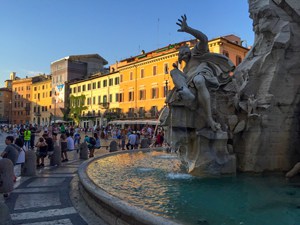
The Pantheon is Rome’s most intact ancient monument and the largest unreinforced concrete dome in the world. Formerly a pagan temple built in AD 125 by Emperor Hadrian, it only survived since it was later repurposed as a church in the 7th century. Buried here are the two first Kings of Italy and the artist Raphael.
Its oculus, the hole in the dome, allows both sunlight and rain to pour through. Michelangelo studied the dome and oculus before he designed the cupola of St Peter’s Basilica.
• Relax in the Piazza Navona
When exiting the Pantheon turn left and walk 3-minutes to San Luigi del Francesi (Church of St. Louis of the French). In the church’s Chapel of St. Matthew, you’ll find three religious works (including at least one reproduction) by Caravaggio. Note that if you’d like to attend a mass here, this is the official parish of France in Rome and masses are in French.
One block to the west (a 5-minute-walk) is the beautiful and very popular Piazza Navona. It’s an elliptical plaza built atop a Roman racecourse, a stadium once used for chariot races. It’s now one of the city’s most famous gathering points.
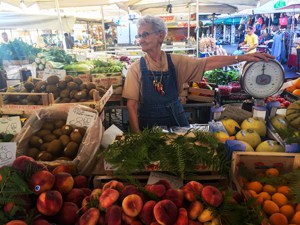
In addition to its famous baroque fountain (Bernini’s “Fountain of the Four Rivers”) and the church of Sant’Agnese in Agone, you’ll also find plenty of artists with their works for sale.
Stop in Bar Tre Scalini (at the north end of the Piazza) for its legendary chocolate tartufo.
Walk directly south of the Piazza for 5-10 minutes, and you’ll find Campo de’ Fiori, the “field of flowers.” Campo de’ Fiori is famous for its morning market, as well as its neighborhood nightlife.
On the other hand, if you’d like to see the market, simply reverse the order of this walk and start at the Campo. In the morning, you’ll find plenty of cafes in the neighborhood serving coffee and breakfast snacks.
Campo de’ Fiori also has its dark side: it was the site of executions during the Inquisition. The statue in the center is that of Giordano Bruno, a philosopher burned at the stake during celebrations in 1600.
If You Go:
Trevi Fountain
https://www.turismoroma.it/en/places/trevi-fountain
Open: 24 hours a day
Admission: Free
Pantheon
https://www.pantheonroma.com/home-eng/
Open: Monday–Saturday 8:30 am – 7:30 pm (last admission 7:15 pm) / Sunday 9:00 am – 6:00 pm (last admission 5:45 pm)
Admission: free
San Luigi del Francesi
https://romanchurches.fandom.com/wiki/San_Luigi_dei_Francesi
Open: Monday – Friday 9:30 am – 12:45 pm and 2:30 pm – 6:30 pm / Saturday 9:30 am – 12:15 pm and 2:30 pm – 6:45 pm / Sunday 9:30 am – 12:15 pm and 2:30 pm – 6:45 pm
Admission: free
Piazza Navona
https://www.turismoroma.it/it/node/1516
Open: 24 hours a day
Admission: free
Campo de’ Fiori
https://www.turismoroma.it/en/places/campo-de%E2%80%99-fiori-and-piazza-farnese
Open: 24 hours a day, although the market is operational only during normal business hours.
Admission: free
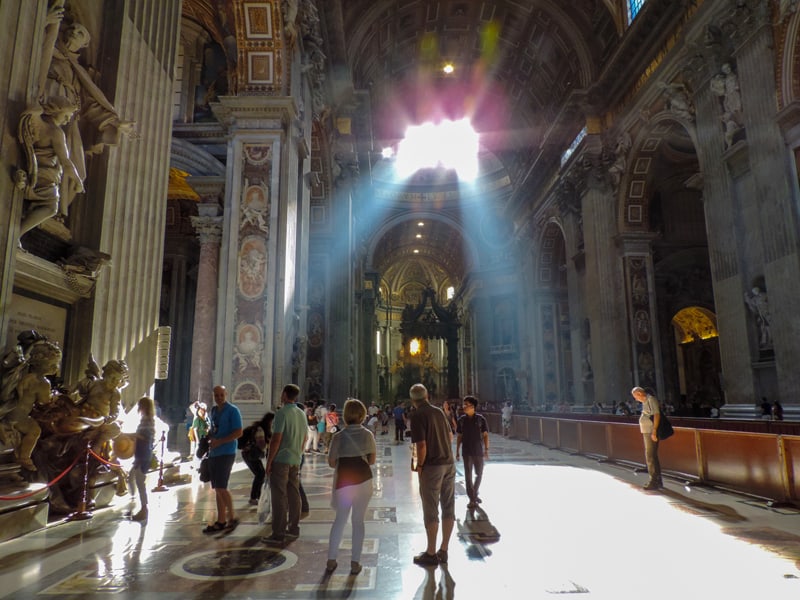
#5 Vatican City
Vatican City is the world’s smallest country. However, unbeknownst to many, Vatican City houses the largest concentration of art in the world. You’ll be amazed by it.
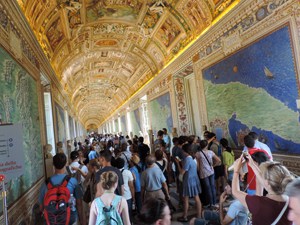
Like the Villa Borghese walk, it’s well worth a half- or full day. In fact, inside the Vatican Museum, you could walk 4+ miles (7km) before you even reach the Sistine Chapel. It’s that spectacular.
The Vatican Museum is so spectacular art-lovers on a walk in Rome can easily spend an entire day there. But don’t miss the treasures in St. Peter’s Basilica, including Michelangelo’s “Pietá.”
• Go Up On the Roof of St. Peter’s
A few tips…on the left side of the Basilica is an elevator that will take you to the roof (the cost is €10). From there, you can walk up the stairway in the dome. If you’d rather walk up to the roof (231 steps) and then climb the additional 320 steps in the dome, the cost is €8.
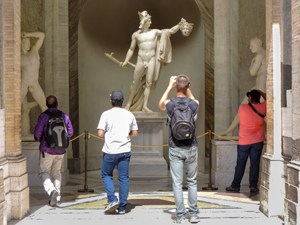
The roof is a good experience (you won’t believe how large those statues are) and there’s a small café there. It’s a good place to take a break.
If you want include the top of the dome on this walk in Rome, remember that it’s all uphill, it’s narrow, and there’s no turning back since there’s a line behind you. And at times, there’s a long wait – sometimes more than an hour – to get on the stairway (usually only during the high tourist season). I’ve done it twice and don’t need to do it again.
If You Go:
St. Peter’s Basilica
https://stpetersbasilica.info/touristinfo.htm
@ [email protected]
Open: April 1 – September 30, 7:00 am – 7:00 pm / October 1 to March 31, 7:00 am – 6:00 pm
Admission: free to the Basilica and Papal Tombs. However, there are fees for the elevator to the roof and for the walk up the dome.
Vatican Museums
https://m.museivaticani.va/content/museivaticani-mobile/en.html
@ [email protected]
Open: Monday–Saturday 9am–6pm (last entry at 4pm) / during the summer months there are extended opening hours until 10:30pm (last entry 8:30pm) / last Sunday of every month the museums are open 9am–2pm (last entry at 12:30pm).
Admission: Adult €17; Children (6-18) €8 /audio guide €7; Children 6 years and younger free.
Note: Normally tickets can be purchase at the museum’s entrance but check online in advance. See here for all prices.
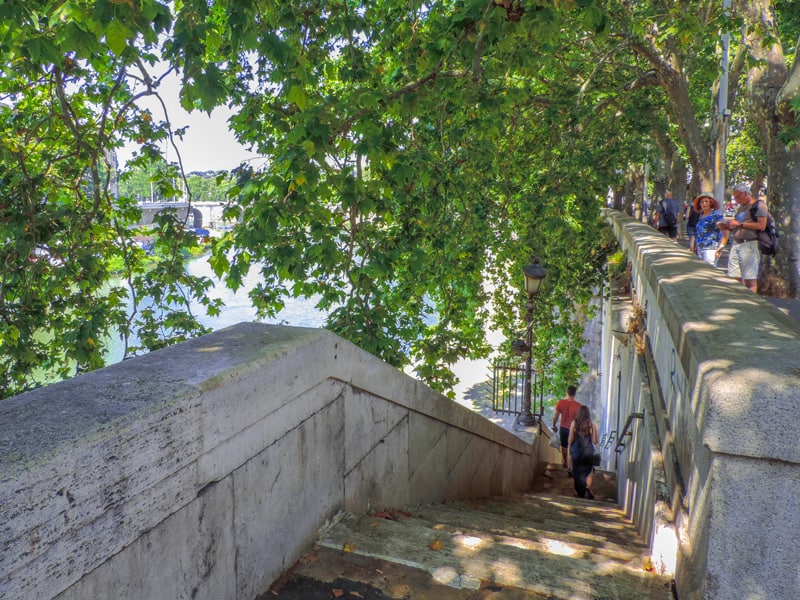
#6 A “Different” Walk in Rome – Stroll Along the Tiber
Although any people never think of taking a stroll along the Tiber, the famous river that bisects the Italian capital, it is quite enjoyable.
Look at a map of Rome and decide what you’d like to see along the river. You don’t need to go down to the river unless you want to but just walk along the sidewalks above it.
You may also enjoy A Dream Vacation: Renting A Villa in Italy / Puglia Road Trip (With a Map) — Italy’s Sensational Adriatic Coast / Italy’s Secret Treasure: Friuli Venezia Giulia Province and The Search for My Family in Italy
• The Only Island in Rome
Whichever you do, you’ll see some beautiful sights. In addition, are numerous bridges along the way where you can explore the opposite bank on your return.
Right off Trastevere, Rome’s old neighborhood south of the Vatican, you’ll find Isola Tiberina, the only island in Rome. It’s home to a hospital and during the sweltering summer months, is popular for its open-air movies. It’s about a mile / 20-minute walk from the bridge you take across the Tiber to the Vatican.
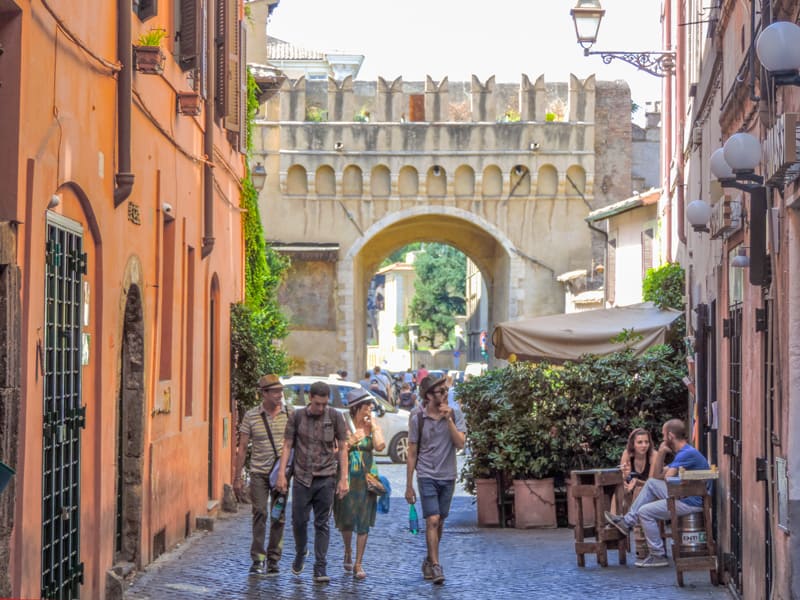
# 7 A Walk in Rome With a Great View – Villa Farnesina to Trastevere
This is a good walk through Trastevere, the old neighborhood of Rome. It’s a part of the city with some great restaurants and a lot of ambiance. You can take this walk in the morning, have lunch in Trastevere, or walk in the afternoon and have an early dinner.
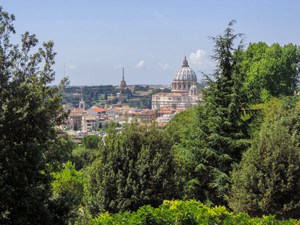
There is, however, one caveat: part of this walk is approximately 200 feet uphill (elevation-wise).
To begin this walk in Rome, go to the Tiber’s Vatican City side and start at the Villa Farnesina, built for a Papal banker in the early 16th century. This luxurious villa was decorated by Renaissance artists including Peruzzi, del Piombo, and Raphael, the latter’s frescoes considered “sensuous” and “mythological.”
You’ll also see some graffiti here. It was left by the troops of Charles V and today is protected as “historical vandalism.”
• Passeggiata del Gianicolo
After you’ve toured the villa, when you exit take Via della Lungara left, toward the gate in the wall (built in the 3rd century).
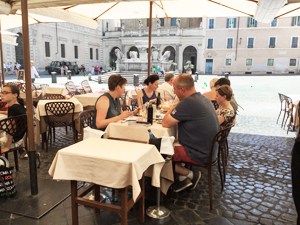
Then turn onto Via Garibaldi and take it to tree-lined Passeggiata del Gianicolo and up to Belvedere del Gianicolo. Although it’s about a 20-25-minute walk, you’ll be rewarded with a beautiful view of Rome.
When you’ve finished taking your photos of the city, start back down Passeggiata del Gianicolo. Upon reaching Via Garibaldi turn right and then immediately left, continuing to head downhill towards the Piazza Santa Maria. If you haven’t already, you should soon see the old church’s bell tower on the Piazza. The entire walk down should only take 12-15 minutes.
If You Go:
Villa Farnesina
http://www.villafarnesina.it/?lang=en
@ [email protected]
Open: Monday – Friday 9:00 am – 2 pm
Admission: Adults €10; Children (10-18 years) €7; Children under 10 years free when accompanied by an adult.
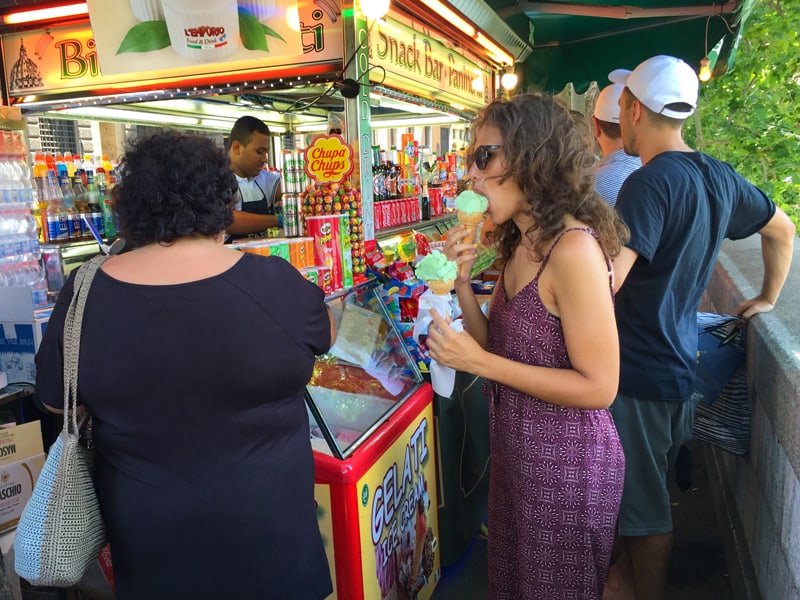
#8 A Delicious Walk in Rome – Finding the Best Gelato
Here’s a fun thing to do. While you’re touring about the city, sample things along the way. One of our writers searched for the best gelato during her walks in Rome… “a delicious piece of research,” she said.
Certainly, like her, you can search for your best gelatos as you walk about Rome every day. Or how about the best pizza in Rome? The best coffee bar? Or just the best bar?
Obviously, in Rome the choices are nearly endless…

Leave a Reply